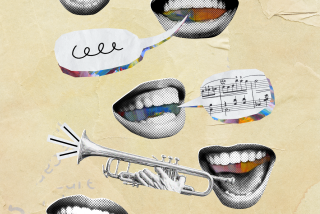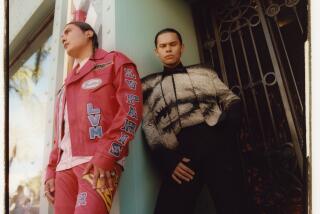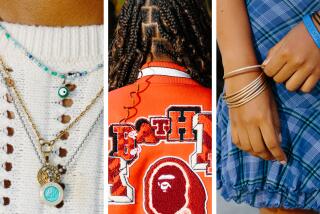A Gift of Beauty and Education
- Share via
Marcel Proust is not on the reading list for Michael Javier’s students. Dead French novelists don’t figure into ESL classes at Evans Community Adult School.
But Proust could have been writing about them: “Only through art can we get outside of ourselves and know another’s view of the universe.”
Javier knows that. His dream--of an art gallery at Evans--has just come true. In a once-empty cafeteria foyer, student art hangs where students used to post notices for used cars and mattresses.
Some are first-time artists. Others once were artists in their homelands, but now are janitors or dishwashers.
This is people’s art. Colorful papier-mache masks. Pastel T-shirts that bear legends of coming to America “with only the shirt on my back.”
With immigrant-bashing rampant, Javier says, “People need to hear their stories, to learn what our students have gone through.”
Javier, 33, an artist himself, is a can-do sort who in 1988 fled the relative complacency of Reseda High for Evans, on the fringe of Downtown. Here, at any given time, the 10,000 students may come from 60 countries.
Although rich in diversity, it is a poor school, with no money for art classes. Javier kept thinking about how important it is for these students to have beauty in their lives and how art spans cultural borders.
From time to time he’d have students do art in ESL classes and would tape their work up in what is now the gallery. Always, it would fall to the floor to be trampled.
On a campus where “they can’t even afford custodians,” he knew there was no way he was going to get start-up money for a proper gallery.
He went to work. Cleaning out his closets, he found some old frames, which he sold to another teacher for $100. That would buy canvases and paint.
Other teachers brought in items for sale. A campus beautification fund yielded $100 for painting the gallery walls and student Cervantes Morales donated the labor.
Students gave nickels and dimes. At Pier 1, Javier bought 50 pairs of 98-cent earrings and sold them at a small profit.
“He’s Mr. Creativity,” says ESL teacher Al Atwood, whose heat transfer press turned out Evans T-shirts to benefit the fund. He wanted this gallery. In his class of so-called slow learners, he has one “who can draw like Michelangelo.”
“We got it open with probably less than $600,” Javier says. This month’s unveiling was a celebration, complete with ice sculptures from the Evans kitchen.
The enthusiasm appears contagious. When Javier’s students are asked how they feel about their teacher, their gallery, the applause is spontaneous: “Excelente!” They speak of the camaraderie of learning about one another.
In one class, everyone made a mask. “I showed them some pictures, sort of Picassoesque, and just let them go,” Javier says.
Lupita Enciso, from Mexico, says her mask is “kind of like a reflection of myself, two different personalities.” In class, she is very serious. But “I like to sing. I like to dance.”
Rhina Zepeda, a pretty young woman from El Salvador, giggles and says she painted her face: “It was almost like I was making up.”
Another piece in the show is a big outline of the United States on which are superimposed students’ recollections of their first day in America. They tell of feeling as helpless as children, unable to speak. They describe their awe at the creature comforts, the freedom.
Javier can relate to strangers in a strange land. He was born in Los Angeles, but he has Portuguese, Filipino, Spanish and Chinese blood. At UCLA, where he majored in English literature, he always felt in cultural “limbo-land.”
Art in ESL classes makes perfect sense to him--a way to teach new words. Brush, glue, paint.
Art field trips have proved an eye-opener to him and his students. One told him: “I didn’t know I could go here. I thought this area was only for white people.” They were at the Museum of Contemporary Art, a 10-minute walk from Evans.
Scrounging money, Javier plans ongoing workshops where students will create art for the gallery. Exhibits will change monthly, sometimes tying in to ethnic holidays. Guest artists will also be invited to exhibit.
Evans Principal Francis Marsala--the son of Sicilian immigrants--is a booster. He knows that good English means better jobs, but “the way to the soul is through the arts.” At Evans, “all the cultures of the world are rubbing up against each other and there’s peace and harmony. There’s hope, you know.”
To Mexican immigrant Felipe Malagon, one of the mask makers, art is one way in which “we can communicate who we are to the wider community, so they will treat us as people instead of objects.”
Evans Adult School is at 717 N. Figueroa St. The gallery is open from 7:30 a.m. to 9:15 p.m. Monday-Thursday, and from 7:30 a.m. to 6:30 p.m. Fridays.
Triumph of the Spirit
It is a Friday evening and, in a Beverly Hills home, about 50 of the faithful have come to meet Olya.
They are Bahais, disciples of a faith with its roots in mid-19th-Century Persia. Olya Roohizadegan, 51, is one of their heroines--sole survivor among 11 Bahai women imprisoned in revolutionary Iran for refusing to denounce their faith.
She does not know why she was saved--”a miracle,” she says--but she understands her mission: to tell the world about the persecution and hangings of the women martyrs known as the Shiraz 10.
Her book, “Olya’s Story,” is as much their story as hers. It is a tale of torture, mob violence, secret burials.
She has told it before the United Nations and the European Court of Human Rights. A movie is in the works. Now, in L.A. for the first time, she is telling it at this Bahai “fireside.”
“I forgive them,” she says of the executioners. “I don’t feel any hate. I pray for them . . . but I cannot forget 10 innocent women.” For two months starting in late 1982, she was their friend and cellmate.
She pulls out fuzzy photos of the women and holds them up one by one. “Who is Shirin?” “Who is Roya?” Ten people step forward, each taking a photo and holding it high. The room is very quiet.
In introducing Roohizadegan, Muhtadia Rice of the local Bahai community had promised, “You will leave here this evening with a great sense of joy.”
That joy is in the slain women’s triumph of the spirit after lifelong persecution in a Muslim nation for their beliefs: equality for all, the oneness of God, their own prophets as well as Mohammed, the Muslims’ sacred messenger.
The women “are now free,” Roohizadegan tells the audience, “but I’m not free” so long as there is anyone who does not know about religious persecution.
Roohizadegan describes her ordeal, her interrogation by guards: “They brought my 3-year-old son, put him in my lap and said, ‘This is your last chance (to recant).’ ”
She could not. She asks, what if “my baby grew up and realized his mother is a liar?”
The price of getting out of prison was the family’s worldly goods. Even then, she lived in fear of being jailed again. Each moment was precious. She visited prisoners, smuggled news of Bahais to the outside world.
Eventually, she escaped with her husband and son overland to Pakistan. They were later reunited with their two older sons in England, where they now live.
She cannot return to Iran: “I am still sentenced to death.”
More to Read
The biggest entertainment stories
Get our big stories about Hollywood, film, television, music, arts, culture and more right in your inbox as soon as they publish.
You may occasionally receive promotional content from the Los Angeles Times.










